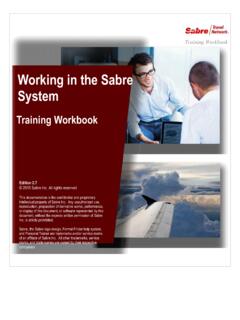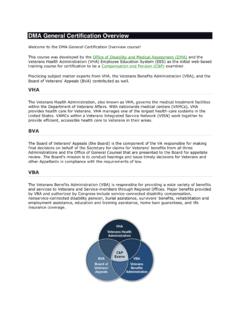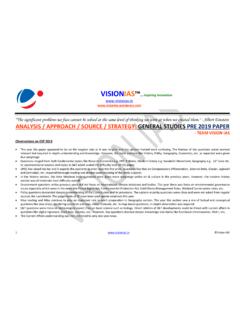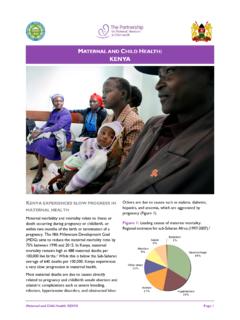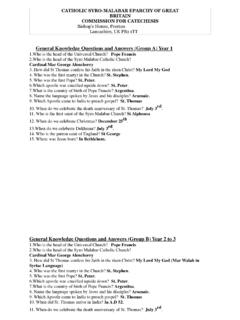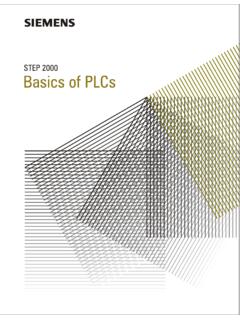Transcription of 2016 - OECD
1 022016 EDUCATION IN DEVELOPING COUNTRIESWHAT POLICIES AND PROGRAMMES AFFECTLEARNING AND TIME IN SCHOOL?Amy Damon, Paul Glewwe, Suzanne Wisniewski, Bixuan Sun Education in developing countries what policies and programmes affect learning and time in school? Amy Damon Macalester College Paul Glewwe University of Minnesota Suzanne Wisniewski University of St. Thomas Bixuan Sun University of Minnesota Rapport 2016:02 till Expertgruppen f r bist ndsanalys (EBA) Amy Damon is an Associate Professor of Economics at Macalester College in St. Paul Minnesota. She received her doctorate in Agricultural and Natural Resource Economics at the University of Minnesota. Her research focuses on education in developing countries as well as household poverty reduction strategies and food security issues in developing countries.
2 Paul Glewwe is a Distinguished McKnight University Professor in the Department of Applied Economics at the University of Minnesota. Before coming the the University of Minnesota in 1999, he was a senior research economist at the World Bank. His research focuses on education in developing countries, and he also does research on child nutrition, poverty and inequality in developing countries, and on education in the United States. Suzanne Wisniewski is an Associate Professor of Economics at the University of St. Thomas in St. Paul, MN. Her research is focused in areas of the economics of education, nutrition, health, migration and poverty in less developed countries. The largest body of her work was on Sri Lanka, in affiliation with World Bank, South Asian Human Development Sector.
3 Other regions of research include Senegal, El Salvador and Peru. Bixuan Sun is a current PhD student in applied economics at the University of Minnesota. Her research focuses on environmental economics and energy policies. She is also interested in program evaluation in developing countries Acknowledgements We would like to thank Stellan Arvidsson Hyving, Sonja Daltung, Eva Mineur, Jesper Sundewall, Jakob Svensson and Anna Tompsett for comments on earlier drafts of this report, and Jay Sayre and Eric Stephens for excellent research assistance. This report can be downloaded free of charge at This work is licensed under the Creative Commons Attribution International License. To view a copy of this license, visit ISBN 978-91-88143-12-9 Printed by Elanders Sverige AB Stockholm 2016 Cover design by Julia Demchenko Table of contens Preface.
4 1 Sammanfattning .. 3 Excecutive Summary .. 8 I. Introduction .. 13 II. Review of Complementary Work .. 17 III. Methodology .. 20 Procedure for Selecting Studies .. 20 Review of the Grey Literature .. 25 Assessment of Intervention Effectiveness .. 26 IV. Common Challenges Faced by the Education Sector .. 29 A Challenge 1: Low Household Demand for Education.. 29 B Challenge 2: Inadequate School Inputs .. 30 C Challenge 3: Ineffective Pedagogy .. 31 D Challenge 4: Low Quality School Governance .. 32 V. Analysis of Interventions that Increase Time in School .. 34 A Interventions to Increase the Demand for Schooling .. 34 B Interventions that Provide School Inputs .. 41 C Pedagogy Interventions .. 47 D Interventions that Change School 49 Summary of What Works for Increasing Time in School .. 53 VI. Analysis of Interventions that Improve Learning Outcomes 56 A Interventions to Increase the Demand for Schooling .. 59 B Interventions that Provide School Inputs.
5 63 C Pedagogy Interventions .. 73 D Interventions that Change School Governance .. 82 Summary of What Works for Increasing Learning.. 90 VII. The Relative Cost Effectiveness of Education Interventions on Test Scores .. 95 VIII. Policy Recommendations .. 102 A Priorities for Education Interventions to Increase Time in School .. 103 B Priorities for Education Interventions to Increase Learning .. 104 C Recommendations Regarding Evaluating and Implementing Interventions .. 105 D Other Recommendations to International Development Agencies .. 109 Bibliography .. 113 Key Definitions and Acronyms .. 130 Appendix 1 .. 132 Appendix 2 .. 200 Appendix 3 .. 203 Previous EBA-reports .. 206 Tables 1 Steps used to Select Papers Reviewed in this Report 2 Summary of Grey literature Search 3 Rubric for Categorizing the effectiveness of Studies 4 Effects of Demand Side Interventions on Time in School 5 Effect of School Inputs on Time in School 6 Effect of Pedagogy Interventions on Time in School 7 Summary of Impacts on Time in School of Governance 8 Effect of Demand-side Interventions on Test Scores 9 Effect of School Inputs on Test Scores 10 Effect of Pedagogy Interventions on Test Scores 11 Effect of Governance Interventions on Test Scores 12 Cost Effectiveness of Interventions in Increasing Test Scores 13 Cost of Further Evaluation by Effectiveness Category Figures 1 Distribution of studies 2 Five Categories of Effectiveness.
6 As Determined by Findings and Number of studies 3 Distribution of Demand Intervention Studies 4 Distribution of School Input Intervention Studies 5 Distribution of Teachinh Pedagogy Intervention Studies 6 Distribution of School Governance Intervention Studies 7 Summary of intervention Effectiveness for Time in School 8 Estimated Impacts of Demand Side Interventions on Test Scores 9a Estimated Impacts of School Inputs on Test Scores 9b Estimated Impacts of School Inputs on Test Scores 10a Estimated Impacts of Pedagogy Interventions on Test Scores 10b Estimated Impacts of Pedagogy Interventions on Test Scores 11a Estimated Impacts of Governance Intervention on Test Scores 11b Estimated Impacts of Governance Intervention on Test Scores 12 Summary of Intervention Effectiveness for Learning Outcomes 1 Preface One important challenge for development aid lies in the ability to (directly or indirectly) reinforce human capital in low- and middle-income countries, thereby positively affecting economic growth, and ultimately, to achieve poverty reduction.
7 It is hardly possible to envisage long-term poverty reduction in the world's low- and middle-income countries that is not preceded by strengthened education systems and a more educated population. The links between education and economic growth, income distribution and poverty reduction are well established. On top of this, education is also a basic human right and a foundation for a more sustainable and inclusive society. The central and prominent role of education in global development has recently been confirmed by the Sustainable Development Goal 4: "Ensure inclusive and equitable quality education and promote lifelong learning". To increase the prospects of achieving the global goal of education for all, effective, good quality education policies, strategies and programmes must be in place. The difficult part is to finding out what type of interventions is likely to work best in a given community or school.
8 There are also many context-specific problems in the education sector that need to be addressed, such as low school attendance, ineffective pedagogy and unsatisfactory school performance in terms of test scores. Studies and research conclude that many children in low- and middle- income countries leave the school system without being able to read simple texts or perform simple mathematical exercises. In development research, education is repeatedly cited as crucial from a variety of perspectives. At the same time, this sector has not been prioritised in Swedish development aid, despite substantial and alarming needs in low- and middle- income countries and despite the lack of funding for education systems. Donors and the research community on international education build up a considerable knowledge base, with hundreds of evaluations and impact studies with (potentially) important conclusions to draw on for effective future investment in the sector.
9 However, the question remains how accessible and useful this knowledge base is, and also whether it is actually used by policy-makers and officials deciding on aid to education. This was the startingpoint for the Expert group for Aid Studies when it decided to commission two synthesis evaluations on aid to education. In this report, Professor Paul Glewwe, Amy Damon, Suzanne Wisniewski and Bixuan Sun have made a comprehensive review and 2 analysis of recent research on education policies, programmes and interventions in developing countries. Their objective is to provide a tool to policy makers and donors who wish to know what research in the field has to say about effectiveness, for use when planning direct investments in the education sector. The studies included in the review are all based on quantitative analyses, where the causality between intervention and educational outcome has been established through a randomized control trial, regression discontinuity design or a difference-in-differences method.
10 These strict inclusion criteria exclude many studies of educational outcomes, although these are, in part, analysed in the EBA report (2016:03) by Professor Joel Samoff, Jane Leer and Michelle Reddy, who take a completely different research- and methodological perspective. The findings in the report are structured into what works , what often works , what seemsto be promising interventions but need more evidence and what does not seem to work in terms of achieving two broad educational goals: increasing time in school and improving learning outcomes. One of the key findings with respect to get children to increase their time in school is that the provision of conditional cash transfers and merit-based scholarships seem to stimulate improved learning outcomes. Professor Glewwe and his team point to the challenge of choosing the right measure to tackle an identified problem.










